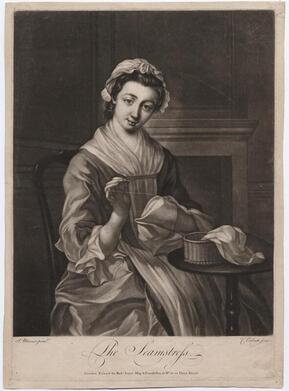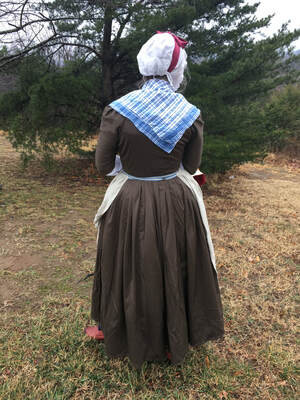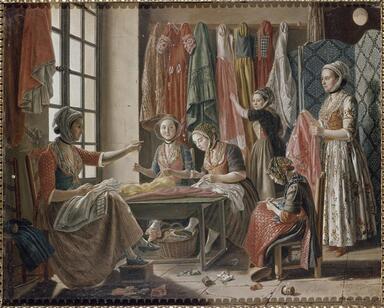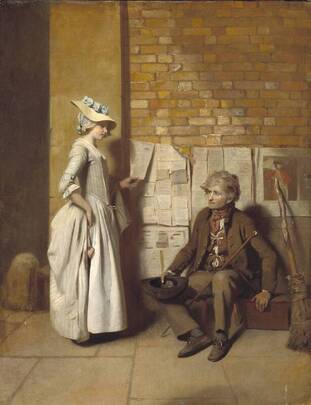
English Gown Sewing Workshop
with Kitty Calash
(Kirsten Hammerstrom)
Saturday, May 30 & Sunday, May 31
Reservations Required
Max: 8 Participants
Light breakfast and boxed lunch are included in registration fee.
Gown Workshop
$200.00
English Gown Sewing Workshop
with Kitty Calash (Kirsten Hammerstrom)
Saturday, May 30 & Sunday, May 31
Reservations Required
Limited to 8 participants
For a full list of required materials and a full schedule, visit: https://www.barracks.org/gown_workshop.html
After registering, please fill out this questionnaire.
1775 -1783 English Gown Workshop
In this workshop, we will use draping to create a well-fitted bodice and sleeve shape for each participant. If you already have bodice pieces or a pattern that fits you, or nearly does, bring them and we will work from those to create the ideal fit. We will make open-skirted, pleated back English gowns with either closed fronts or stomacher fronts, depending on the student’s individual preference.
Students will work in pairs to assist each other with draping, with oversight and assistance from the instructor. Once we have completed pattern pieces, we will cut linings and begin construction, starting with including back pleating for fit, attaching bodice fronts, sewing and setting sleeves. There will be homework, and we will not be able to complete the gown in the workshop-- there is just too much sewing to do! All sewing will be by hand.
Schedule:
Saturday 9 to 5: We will start promptly at 9 with introductions and an overview of the workshop’s goals before a brief illustrated lecture on gowns. After that, we will pair up by height and begin draping. By the afternoon, we should have custom pattern pieces for bodice back and front, sleeve, and shoulder strap pieces, and be ready to cut out the linings. We will start with the bodice back lining and move on to draping the back pleats.
Sunday 9 to 3: The goal for Sunday is to get back pleats stitched down, bodice front linings and fashion fabric attached, and sleeves set. Some of this work may be in basting only, but we will get you well on your way to a well-fitted hand-sewn gown.
Skill Level: Intermediate
Participants should have completed at least one 18th century woman’s garment like a bedgown or shift, and be familiar with hand-sewing stitches and period techniques. While these stitches will be gone over in class, familiarity is recommended for the optimum experience!
Materials required:
Muslin (~3 yards) or other lightweight cotton fabric for draping. Muslin is available from the instructor at $15 for a three-yard piece; please contact her by May 8th.
Gown lining: ~1 to 1.5 yards at 54” medium weight linen. Do not use cotton. If your garment fabric is very fine or lightweight, you may wish to use white instead of unbleached linen; however, most period garments used unbleached linen since linings are hidden.
Optimal Lining Fabrics:
Natural Medium Weight Linen at Burnley & Trowbridge
Fine Oznabrig Linen at Wm Booth Draper
Garment Fabric:
Depending on your size and height, you will need 4 to 6 yards of 54” wide fabric for a gown. A matching petticoat will require an additional 2-3 yards depending on your size and height. Burnley and Trowbridge, Wm Booth Draper, Renaissance Fabrics and other online vendors have excellent options; you can also shop in the garment district in Philadelphia or New York.
Appropriate Fabrics: printed cotton, lightweight plain-weave wool, solid or striped linen; check linen. The appropriateness of pattern and type of fabric varies depending on your impression and location. What’s worn in New England is different from what is worn in Virginia-- even in New England, there are far more printed cottons in Rhode Island than there are in Boston! The instructor does have some appropriate fabrics for purchase if desired; contact her for more information ([email protected]) and for advice on selecting fabric.
Stitches:
The stitches we will use are: running stitch, back stitch, mantua maker’s stitch, slip or hemstitch, and combination stitch. Practicing in advance of the class is recommended to gain confidence and speed.
Notions Required:
Linen sewing thread that matches your fabric, or unbleached or white linen sewing thread
Cotton basting thread (quilting cotton is ideal) in a contrasting color
Tailor’s Chalk
Pencil(s)
Fabric shears
Thread snips
Pins
Thimble
Needles
Ruler
Notebook
You will need to wear a shift, stays, and petticoat for fitting; you may wish to bring a bedgown, sweater, or other coverup to wear when sewing.
Stays are required for this workshop.
In this workshop, we will use draping to create a well-fitted bodice and sleeve shape for each participant. If you already have bodice pieces or a pattern that fits you, or nearly does, bring them and we will work from those to create the ideal fit. We will make open-skirted, pleated back English gowns with either closed fronts or stomacher fronts, depending on the student’s individual preference.
Students will work in pairs to assist each other with draping, with oversight and assistance from the instructor. Once we have completed pattern pieces, we will cut linings and begin construction, starting with including back pleating for fit, attaching bodice fronts, sewing and setting sleeves. There will be homework, and we will not be able to complete the gown in the workshop-- there is just too much sewing to do! All sewing will be by hand.
Schedule:
Saturday 9 to 5: We will start promptly at 9 with introductions and an overview of the workshop’s goals before a brief illustrated lecture on gowns. After that, we will pair up by height and begin draping. By the afternoon, we should have custom pattern pieces for bodice back and front, sleeve, and shoulder strap pieces, and be ready to cut out the linings. We will start with the bodice back lining and move on to draping the back pleats.
Sunday 9 to 3: The goal for Sunday is to get back pleats stitched down, bodice front linings and fashion fabric attached, and sleeves set. Some of this work may be in basting only, but we will get you well on your way to a well-fitted hand-sewn gown.
Skill Level: Intermediate
Participants should have completed at least one 18th century woman’s garment like a bedgown or shift, and be familiar with hand-sewing stitches and period techniques. While these stitches will be gone over in class, familiarity is recommended for the optimum experience!
Materials required:
Muslin (~3 yards) or other lightweight cotton fabric for draping. Muslin is available from the instructor at $15 for a three-yard piece; please contact her by May 8th.
Gown lining: ~1 to 1.5 yards at 54” medium weight linen. Do not use cotton. If your garment fabric is very fine or lightweight, you may wish to use white instead of unbleached linen; however, most period garments used unbleached linen since linings are hidden.
Optimal Lining Fabrics:
Natural Medium Weight Linen at Burnley & Trowbridge
Fine Oznabrig Linen at Wm Booth Draper
Garment Fabric:
Depending on your size and height, you will need 4 to 6 yards of 54” wide fabric for a gown. A matching petticoat will require an additional 2-3 yards depending on your size and height. Burnley and Trowbridge, Wm Booth Draper, Renaissance Fabrics and other online vendors have excellent options; you can also shop in the garment district in Philadelphia or New York.
Appropriate Fabrics: printed cotton, lightweight plain-weave wool, solid or striped linen; check linen. The appropriateness of pattern and type of fabric varies depending on your impression and location. What’s worn in New England is different from what is worn in Virginia-- even in New England, there are far more printed cottons in Rhode Island than there are in Boston! The instructor does have some appropriate fabrics for purchase if desired; contact her for more information ([email protected]) and for advice on selecting fabric.
Stitches:
The stitches we will use are: running stitch, back stitch, mantua maker’s stitch, slip or hemstitch, and combination stitch. Practicing in advance of the class is recommended to gain confidence and speed.
Notions Required:
Linen sewing thread that matches your fabric, or unbleached or white linen sewing thread
Cotton basting thread (quilting cotton is ideal) in a contrasting color
Tailor’s Chalk
Pencil(s)
Fabric shears
Thread snips
Pins
Thimble
Needles
Ruler
Notebook
You will need to wear a shift, stays, and petticoat for fitting; you may wish to bring a bedgown, sweater, or other coverup to wear when sewing.
Stays are required for this workshop.



